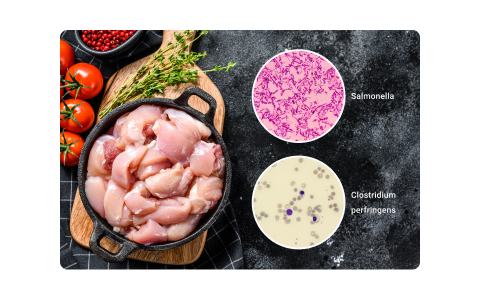Understandably, food businesses, including early childhood services, that handle, prepare or serve food are regulated and enforced within Australia to ensure food safety and that the food is fit for human consumption.
By the end of this topic, you will understand:
- The relevant food safety standards that apply to the safe handling of food
- The requirements for implementing a food safety program to manage any risks relating to food safety hazards
- The relevant legislation that applies to food handling in Australia and its states and territories
- The key points relating to Hazard Analysis and Critical Control Points
In this topic, you will learn about:
- The five (5) food safety standards within The Australia New Zealand Food Services Code, and how they apply to food businesses and early childhood services in relation to food handling, preparation and serving
- Various legislation that regulates food handling businesses
- Food safety in ECEC
- Hazard analysis and critical control points.
Relevant legislation
- The standards in the Australia New Zealand Food Services Code are legislative instruments under the Legislation Act 2003. You can access the Code (Standard 3.2.2 – Food safety practices and general requirements) through this link. The individual standards can be accessed through Food Standards Australia and New Zealand’s official website. You’ll learn more about them in detail.
- Early childhood services are regulated by the Education and Care Services National Regulations. The relevant food-related regulations are covered in Regulation 77 (‘Health, hygiene and safe food practices’), Regulation 78 (‘Food and beverages’). Regulation 79 (‘Service providing food and beverages) and Regulation 80 (‘Weekly menu’)1. You’ll read more about these regulations throughout this topic.

The Australia New Zealand Food Services (the Code) contains various food industry standards, and five of those standards relate specifically to food safety (Food Safety Standards). The Food Safety Standards are designed to hold food businesses to account in the safe production and handling of food, with the aim, as specified by Food Standards Australia New Zealand (FSANZ), to ‘lower the incidence of food-borne illness’. The food safety standards also contain health and hygiene information and set out obligations for businesses and workers2.
A food business is any business or activity that involves the handling of any type of food for sale, or the sale of food in Australia.Food Standards Australia New Zealand (FSANZ)
The food safety standards apply to any food business, including any early childhood service that prepares or serves food.
Food Safety Australia New Zealand (FSANZ) sets the food safety standards following policy and policy guidelines developed by the relevant appointed ministers responsible for food regulation. The food safety standards are enforced by state and territory governments.
Local councils implement the legislation at the local level. This is done through registration and the monitoring and inspection of any premises where food is stored and served, including childcare centres. Important actions include education and enforcement, and the taking of food samples could potentially occur.
The following 2-minute video explains the role of Food Safety Australia New Zealand (FSANZ):
Safe Food Australia
Safe Food Australia is a publication issued by the Australian Government. It guides government agencies working in relevant food-related enforcement roles on the food safety standards. This resource may also be valuable to those working in food handling roles.
The five (5) food safety standards are:
- 3.1.1 Interpretation and application
- 3.2.1 Food safety programs
- 3.2.2 Food safety practices and general requirements
- 3.2.3 Food premises & equipment
- 3.3.1 Food safety programs for food service to vulnerable persons
Read
Access the Safe Food Australia guide (3rd Edition) by Food Standards Australia New Zealand and have a read through. You will be able to explore parts of the guide in more detail throughout this module.
THE VARIOUS RELEVANT STATE AND TERRITORY LEGISLATION IS ALSO SET OUT AS FOLLOWS:
(To view each state/territory's legislation, click on the sign within the relevant state/territory.)

Note
The relevant Standard for dealing with food safety programs is:
Early childhood services who prepare or serve food are required to implement a food safety program that complies with food safety standards. The development of the program will usually be the responsibility of the early childhood service director and the cook or primary food handling employee. Once the program has been developed, it is the responsibility of all staff, including management and educators to comply with the program when preparing or serving food.
The food safety program will determine how the early childhood service will manage any risks associated with potential food safety hazards. This should be in the form of a written document that sets out the controls the early childhood service has in place to manage any potential food safety hazards.
The food safety program is in compliance with Standard 3.2.1 and in accordance with Standard 3.3.1. Food businesses, including early childhood services, will be audited periodically by a qualified auditor who has been approved by the Department of Health. Audits will be carried out to ensure food businesses are complying with their food safety program and that they are managing any potential food safety hazards to a high standard.
A food safety program and relevant policies and procedures must include the following:
- Systems to identify and prevent the potential hazards which could occur in daily routines where there is the potential to spread bacteria in early childhood environments, such as checklists or charts used daily/weekly to prevent these hazards.
- Control measures to identify and control potential hazards, such as appropriate food handling and the storage, serving and disposal of food.
- Monitoring systems are in place to constantly evaluate the effectiveness of control measures.
- Correct sanitization procedures used during food handling.
- Possible corrective actions in case of a hazard.
- Regular review of the food safety program to ensure its adequacy.
- Hand washing guidelines and procedures.
Hand washing guidelines and procedures
As a food handling worker, it is your responsibility to follow all organisation procedures that your business has in place relating to its food safety program. You are also required to report any processes or practices you see that are inconsistent with the food safety program and take corrective action within your level of responsibility. Note, under the Education and Care Services National Regulations, regulations 168 and 169, services are required to develop a set of policies and procedures, including in relation to health and safety, including matters relating to nutrition, food and beverages, dietary requirements.
There are many consequences when handling foods unsafely. Consequences could include:
- a greater risk of contamination
- having the business’s licence suspended or cancelled
- business closure
- a higher rate of food poisoning incidents
- bad publicity
- the possibility of prosecution, and
- monetary consequences3.
Here you can read more about compliance requirements for food-related businesses, including compulsory food safety training for staff and non-compliance penalties.
This guideline developed by ACECQA provides an overview of all legislative requirements regarding nutrition, food and beverages and dietary requirements. The document also includes a glossary with key terms and guidelines on how to develop effective and compliant policy and procedure documents on this topic. The guideline also outlines the key stakeholders’ roles and responsibilities. Here’s an example of educators’ roles and responsibilities4:
Educators:
- implement the Nutrition, food and beverages, dietary requirements policy and procedures
- handle, prepare and store food using safe practices, in line with Australian food safety standards and any jurisdictional requirements
- ensure safeguards are in place to prevent children being provided the wrong food or breast milk
- ensure children have access to safe drinking water at all times and are offered food and beverages appropriate to each child’s needs on a regular basis throughout the day
- monitor children’s food and beverage intake to ensure it is adequate and appropriate to each child’s needs
- be familiar with the individual needs and action plans for the children in your care with specific dietary requirements, and ensure those requirements are taken into consideration, including on excursions
- maintain ongoing communication with families and other members of staff (including the Nominated Supervisor) about any changes to children’s dietary requirements and ensure these changes are reflected in the mealtimes
- implement and reflect on program planning to:
- promote healthy eating and knowledge of nutrition by children, e.g. eating with the children, conversations during mealtimes around food
- promote healthy eating among families
- involve children in decision-making about healthy food and beverage choices, e.g. having them assist with food preparation.

Do all staff have the skills and knowledge to care for food safely?
Anyone involved in the stages of food handling must have the skills and knowledge to do so safely. The chef or cook in the kitchen requires different skills and knowledge, (such as Food safety supervisor training) compared to an educator who is involved in serving food to children who has had more basic training and general food safety knowledge and skills.
It is important that knowledge is current and reflected on frequently. A regular food safety agenda item at staff meetings is an effective way of ensuring food safety knowledge is current and at the forefront of mind. One month it may cover correct hand washing and another month, it may cover food storage or cleaning. This is integral in ensuring that food safety remains a priority in the service.
The correct skills and knowledge of everyone involved in food handling is an important safeguard to promote the health and safety of children while minimising risks and protecting children from harm (NQS Quality Area 2).
Is the environment appropriate for the amount and type of food being stored?
All food storage areas must be clean, pest-free and well-maintained (NQS Element 3.1.2). Food must be in sealed containers or bags and correctly labelled with the product name, opened date and 'best before 'date.
Items must be stored in accordance with manufacturer’s instructions. If a product is opened, it is important that the storage instructions are followed. Storage instructions may state that the products must be refrigerated after opening or stored in a cool dry place. These requirements should always be checked and followed before storing foods.
It is important to consider that dry storage areas include pantries, cupboards or rooms where low-risk foods are stored.
How to ensure the food in your fridge stays at the correct temperature include:
- Avoid overloading
- Ensure hot food has stopped steaming before putting it into the fridge
- Minimise the time the door is held open
- If lunchboxes or insulated lunch bags are brought in by families, ensure there is enough space to store these in a fridge and that insulated bags are unzipped to allow cool air to circulate.
Is food cooked or reheated to safe temperatures?
Cooking and heating food kills off pathogenic microorganisms if the correct temperatures are reached. It is important to consider the following:
- Cooking temperature – Potentially hazardous foods such as meat, poultry, eggs, seafood and cooked rice and pasta are required to be cooked to an internal temperature above 75°C to ensure any pathogenic microorganisms in the products are killed off.
- Reheating temperature – Once potentially hazardous foods have been cooked above 75°C and then cooled for later use, they can then be reheated once to a temperature above 60°C.
To ensure the safety of cooked and reheated food:
- Test internal food temperature with a probe thermometer and document temperature reached
- Ensure thermometers are cleaned and sanitised after every use
- Cooked and reheated food will need to be cooled for a short period of time to allow it to drop to a safe temperature for children to consume. Portioning food into small bowls/plates will help speed up cooling time
- Prevent cooling food from contamination.
Young children are a highly vulnerable group when it comes to food poisoning and it is important that we all take every practical measure possible to ensure their safety while they attend a service.
Reflecting on your own food safety practices and the measures in place at your service is important to do regularly due to the ever-changing nature of the food environment. Doing so will highlight what is being done well and what may require improvement to ensure the provision of safe food for children. For more information, refer to the Guide to the NQF: Quality Area 2.
Note
The relevant Standard for dealing with Hazard Analysis and Critical Control Points is:
Hazard Analysis and Critical Control Points (HACCP) is a method of controlling food safety originally developed by the National Aeronautics and Space Administration (NASA) in the 1960s.
The aim of HACCP is to identify any potential food hazards so that appropriate controls, management and mitigation can be put in place, and involves a risk assessment relating to each step of the food supply chain.
The seven (7) key principles of HACCP are:
- Hazard analysis - identifying any reason food may become unsafe.
- Critical control points - a procedure applied to manage a food risk.
- Critical limits - the limits of each critical control point applied to keep food safe (for example, setting the appropriate temperature limits for food storage).
- Critical control monitoring - Ensuring critical control points are monitored and that critical limits are adhered to.
- Corrective action - The action to be taken if critical limits are exceeded.
- Procedures - A record of the procedure that will be maintained to ensure the safe production of food.
- Record keeping - Any records a business or early childhood service keeps such as their food safety plan.
The seven HACCP principles are included in the international standard ISO 22000 FSMS 2005 and are implemented in many Food Safety Programs all around the world6.
HACCP Support programs:
- Health & hygiene requirements for food handlers
- Good manufacturing process policy
- Approved supplier program
- Calibration registration
- Cleaning and sanitaiton
- Pest control
- Quality policy
- Training
Watch the following 4-minute video about how to create a HACCP Plan:
The following 4-minute video will further explain the seven principles of HACCP:
Read
Read about the history of HACCP in The History of HACCP by Safe Food Alliance.
Use the following questions to check your knowledge. You can check the correct answer by clicking on the 'Answer' button:
-
TRUE OR FALSE: There are only five standards relating to food in The Australia New Zealand Food Services Code.
False. The Australia New Zealand Food Standards Code includes food standards (Chapter 2), the five (5) food safety standards (Chapter 3) and primary production standards. -
What is the purpose of a food safety program?
To set out information about how the early childhood service will manage any risks associated with potential food safety hazards. -
Who is responsible for complying with the food safety program?
All workers -
What should you do if you notice an inconsistency in your early childhood service, compared to what is required in the food safety program?
Report to your supervisor and take corrective action within your level of responsibility. -
What does the acronym HACCP stand for, and what is it?
Hazard Analysis and Critical Control Points. A method of controlling food safety.

